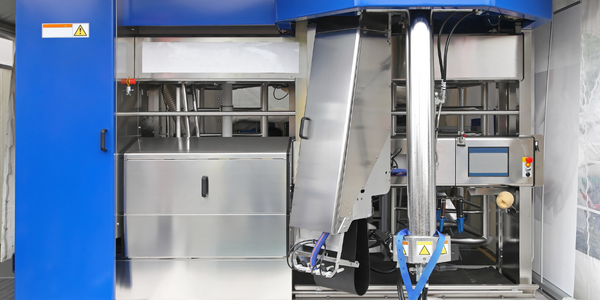ίΙ╢ώΑιύ│╗ύ╗θϋΘςίΛρίΝΨ

- ό▒╜ϋ╜ο
- ϋχ╛ίνΘϊ╕Οόε║όλ░
- ύο╗όΧμίΙ╢ώΑι
- ϊ║πίΥΒί╝ΑίΠΣ
- ϋ┤ρώΘΠϊ┐ζϋψΒ
ίΖρύΡΔόβ║ϋΔ╜ίΙ╢ώΑιί╕Γίε║ί░Ηί┐τώΑθίληώΧ┐Ύ╝ΝώλΕϋχκίΙ░ 2023 ί╣┤ί░Ηϋ╛╛ίΙ░ 4790.1 ϊ║┐ύ╛ΟίΖΔί╖οίΠ│ήΑΓ
ϋ╡ΕόΨβόζξό║ΡΎ╝γώΦκίχΚί╕Γίε║ύιΦύσ╢
ϋΘςίΛρίΝΨίΙ╢ώΑιύ│╗ύ╗θίοΓϊ╜ΧόΠΡϊ╛δίΧΗϊ╕γϊ╗╖ίΑ╝Ύ╝θ
έΩΠ ίΣαί╖ξόδ┤ίχΚίΖρ
έΩΠ όΠΡώταύΦθϊ║πίΛδΎ╝Ι24/7 ϋ┐ΡϋκΝόΩ╢ώΩ┤Ύ╝Κ
έΩΠ όΠΡώταϊ║πίΥΒϋ┤ρώΘΠ
έΩΠ όδ┤ώταύγΕόΦ╢ύδΛ
έΩΠ όδ┤ίΘΗύκχύγΕόΧ░όΞχώΘΘώδΗ
ϋΘςίΛρίΝΨί╖ξϊ╕γύ│╗ύ╗θϊ╕Ξϊ╗ΖόΠΡώταϊ║ΗύΦθϊ║πϋΔ╜ίΛδΎ╝ΝϋΑΝϊ╕ΦόΠΡώταϊ║ΗύΦθϊ║πϋ┤ρώΘΠΎ╝ΝίΡΝόΩ╢όΠΡώταϊ║ΗόΥΞϊ╜εϋχ╛ίνΘύγΕίΣαί╖ξύγΕίχΚίΖρόΑπήΑΓϋ┐βϊ║δύ│╗ύ╗θϋ┐αίΠψϊ╗ξώΖΞύ╜χϊ╕║όΠΡϊ╛δόδ┤ίΘΗύκχύγΕόΧ░όΞχΎ╝Νϊ╗ξϊ╝αίΝΨϋΨΕί╝▒ύΟψϋΛΓί╣╢ίνπίνπίΘΠί░Σϊ║║ϊ╕║ώΦβϋψψίψ╝ϋΘ┤ύγΕϊ║πίΥΒύ╝║ώβ╖ήΑΓ
ί╛χύΦ╡ύ╜ΣόεΚϊ╗Αϊ╣Ιίξ╜ίνΕΎ╝θ
ϊ╕║ύΦ╡ύ╜ΣύγΕόεΑύ╗ΙύΦρόΙ╖ίΤΝϋ┐ΡϋΡξίΧΗόΠΡϊ╛δύΦ╡ϋΔ╜ϋ┤ρώΘΠήΑΒίΠψώζιόΑπίΤΝίχΚίΖρόΑπ
ίΛιί╝║ίΙΗί╕Δί╝ΠϋΔ╜ό║ΡίΤΝίΠψίΗΞύΦθϋΔ╜ό║ΡύγΕόΧ┤ίΡΙ
ίΖ╖όεΚόΙΡόευύτηϊ║ΚίΛδίΤΝόΧΙύΟΘ
Ύ╗┐ίχηύΟ░όβ║ϋΔ╜ύΦ╡ύ╜ΣόΛΑόεψώδΗόΙΡ
όευίε░όΟπίΙ╢ύγΕύΦ╡ϋΔ╜ϋ┤ρώΘΠ
ώΑγϋ┐ΘόεΑίνπώβΡί║οίε░ίΙσύΦρί╜Υίε░ό╕Ζό┤ΒϋΔ╜ό║ΡίΠΣύΦ╡Ύ╝ΝόεΑίνπώβΡί║οίε░ίΘΠί░Σύλ│ϋ╢│ϋ┐╣ίΤΝό╕σίχνό░Φϊ╜ΥόΟΤόΦ╛
Ύ╗┐ίληίΛιίχλόΙ╖Ύ╝ΙόεΑύ╗ΙύΦρόΙ╖Ύ╝ΚίΠΓϊ╕Οί║ο
ίΙ╢ώΑιόΛΑόεψύγΕόεΑόΨ░ϋ╢ΜίΛ┐όαψϊ╗Αϊ╣ΙΎ╝θ
όΨ░ύγΕίΙ╢ώΑιόΛΑόεψϊ╕ΞόΨφό╢ΝύΟ░ήΑΓϋ┐Σί╣┤όζξύγΕϊ╕Αϊ║δόεΑίνπϋ╢ΜίΛ┐ίΝΖόΜυΎ╝γ
- 3D όΚΥίΞ░Ύ╝γίΘιϊ╣ΟίΠψϊ╗ξϊ╜┐ύΦρώΘΣί▒ηήΑΒίκΣόΨβίΤΝίΖ╢ϊ╗ΨόζΡόΨβίΙ╢ώΑιϊ╗╗ϊ╜Χύ╗Εϊ╗╢Ύ╝Νύ╝σύθφϊ║νϋ┤πόΩ╢ώΩ┤ί╣╢ύχΑίΝΨϊ╗Οϋχ╛ϋχκίΙ░ύΦθϊ║πύγΕό╡ΒύρΜ
- ϊ║ΣόεΞίΛκΎ╝γϊ╗Οϊ╗╗ϊ╜Χϊ╜Ξύ╜χί┐τώΑθόεΚόΧΙίε░ίχηύΟ░όΧ░όΞχίΤΝόεΞίΛκύγΕϋβγόΜθίΖ▒ϊ║τ
- ύΚσϋΒΦύ╜Σ (IoT)Ύ╝γϊ╕Ξϊ╗ΖόΦ╣ίΠαό╢Ιϋ┤╣ί╕Γίε║Ύ╝Νϋ┐αόΦ╣ίΠαίΙ╢ώΑιϋ┐ΘύρΜϊ╕φϊ╜┐ύΦρύγΕύΦ╡ίφΡϋχ╛ίνΘύγΕύ╗┤όΛνίΤΝϊ┐ζίΖ╗
- ύ║│ύ▒│όΛΑόεψΎ╝γίχηύΟ░όδ┤ί┐τύγΕϋχκύχΩόε║ίνΕύΡΗήΑΒόδ┤ώΧ┐ύγΕϊ║πίΥΒύΦθίΣ╜ίΣρόεθίΤΝϋ╢Ζύ▓╛ίψΗίΙ╢ώΑιΎ╝Νϊ╗ξίΠΛύσ║ώΩ┤ί╖ξύρΜίΤΝύΦθύΚσόΛΑόεψύφΚώλΗίθθύγΕί╝ΑίΙδόΑπϋ┐δόφξ
- ίΖΙϋ┐δύγΕόΧ░όΞχίΙΗόηΡίΤΝώλΕό╡ΜόΛΑόεψΎ╝γίερίΙ╢ώΑιϋ┐ΘύρΜϊ╕φίχηύΟ░όδ┤ίξ╜ύγΕϋ┐ΘύρΜόΟπίΙ╢ήΑΒύ╝║ώβ╖ώλΕώα▓ίΤΝόδ┤ί┐τύγΕίΥΞί║ΦόΩ╢ώΩ┤
- ί╖ξϊ╕γόε║ίβρϊ║║Ύ╝γώΑγϋ┐ΘϋΘςίΛρίΝΨίδ░ώγ╛όΙΨίΞΧϋ░ΔύγΕϊ╗╗ίΛκΎ╝ΝόΠΡϊ╛δόΠΡώταύΦθϊ║πίΛδήΑΒόΠΡώταϋ┤ρώΘΠίΤΝώβΞϊ╜ΟόΙΡόευύγΕόΨ╣ό│ΧήΑΓ
ίΙ╢ώΑιύ│╗ύ╗θϋΘςίΛρίΝΨώζλϊ╕┤ύγΕόεΑίνπόΝΣόΙαόαψϊ╗Αϊ╣ΙΎ╝θ
έΩΠ ίΙζίπΜόΛΧϋ╡ΕόΙΡόευ
ίχηόΨ╜ϋΘςίΛρίΝΨίΙ╢ώΑιύ│╗ύ╗θίΠςόεΚϊ╕Αϊ╕ςύεθόφμύγΕύ╝║ύΓ╣Ύ╝ΝώΓμί░▒όαψίΙζίπΜόΙΡόευήΑΓϋ┐βίΝΖόΜυόε║ίβρόΙΡόευίΤΝίχηόΨ╜ϋΘςίΛρίΝΨύ╝ΨύρΜϊ╗ξίΠΛίθ╣ϋχφίΣαί╖ξϊ╗ξύχκύΡΗϋ┐βϊ║δόΨ░ύ│╗ύ╗θήΑΓύΕ╢ϋΑΝΎ╝Νϋ┐βώκ╣όΛΧϋ╡ΕύγΕόΛΧϋ╡ΕίδηόΛξύΟΘώΑγί╕╕ϊ╝γίερίΘιί╣┤ίΗΖόΦ╢ίδηόΙΡόευήΑΓ
όκΙϊ╛ΜύιΦύσ╢.





